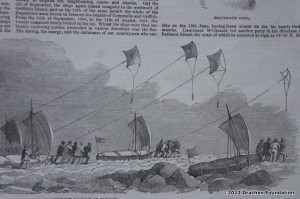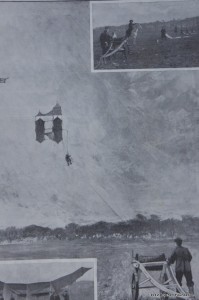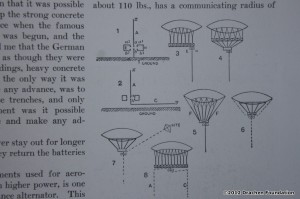Perhaps the following images and details from articles will spur some of you to action. Research, kite-making, or epic adventure, these snippets give you some perspective of the role of kites as tools – easily forgotten when history is finally written.
Several of my favorite historical images come from the Illustrated London News, of which this one is from November 29th, 1851. Here’s an excerpt from the article that accompanies the image:
In the month of May, 1845, Sir John Franklin sailed from England,… in the hope of discovering the Northwest Passage. … more than six years have elapsed since the departure of the Expedition; and when we consider the frightful rigour of an arctic climate, winter after winter, and that the untiring exertions made for their discovery have all proved fruitless, the hope that remains is but faint.
 Certainly, the Franklin expedition is one of the most famous in history and is remembered still in countless books (www.ric.edu/faculty/rpotter/franklit.html) on the subject. But this article gives some detail to the search expedition led by Captain H. T. Austin in 1848. Austin’s adventures were as dangerous and exciting as any expeditions of the day and were compounded by Admiralty hearings upon his return as to the reasons for his failures. But through all of that very fascinating history, the single image from the London News is what turns my head:
Certainly, the Franklin expedition is one of the most famous in history and is remembered still in countless books (www.ric.edu/faculty/rpotter/franklit.html) on the subject. But this article gives some detail to the search expedition led by Captain H. T. Austin in 1848. Austin’s adventures were as dangerous and exciting as any expeditions of the day and were compounded by Admiralty hearings upon his return as to the reasons for his failures. But through all of that very fascinating history, the single image from the London News is what turns my head:
It’s interesting to note that in the Wikipedia entry for Austin, he is “credited with organizing successful sledging expeditions along the coasts of several Canadian Arctic islands.” So, was this the first such use of kites in sledging operations? Was it the last? It’s your turn to find out!
Now, the second and third Illustrated London News images are related. Both have to do with military kite operations and I was struck not only by the images, but by the fact they were published just over a month apart. The first, entitled, “The Kite in the Russian Navy,” shows torpedo boats sending up “flying dragons…”
….now in use in the Russian Fleet. Several of these kites bound together can support a man in the aire. Considerable heights are thus reached, and the invention is admirably adapted for scouting. It is hoped that by this means torpedo-craft will be more easily able to discover the enemy’s ships than they have hitherto been.
 The printed image is said to have come from the sketches of Fred T. Jane, made in the Baltic Sea and few kite people would vouch for the accuracy to the kites shown. But I think it’s amazing that the Russian Navy was actually using these kite systems at the time when S. F. Cody was trying desperately to win over the English military. Which brings us to the third Illustrated London News image: “A rival to the Balloon: the Kite in Warfare.”
The printed image is said to have come from the sketches of Fred T. Jane, made in the Baltic Sea and few kite people would vouch for the accuracy to the kites shown. But I think it’s amazing that the Russian Navy was actually using these kite systems at the time when S. F. Cody was trying desperately to win over the English military. Which brings us to the third Illustrated London News image: “A rival to the Balloon: the Kite in Warfare.”
The familiar images in this drawing come from photographs furnished to the artist by Cody – never one to miss an opportunity at self-promotion – and show the kite train with observer in flight, the winch, and details of one of the kites and of the “kite brigade” readying the system for launch. The News caption follows:
Mr. S. F. Cody is seeking to demonstrate the superiority of the kite over the balloon in warfare by reason of its extreme portability. His kite, or series of kites, which is entirely his own invention, has pulled several men up the side of a mountain otherwise unscalable, and enables the passenger to mount walls and other obstacles. The winding apparatus was specially invented by Mr. Cody.
So, the question that comes to my mind is, could Cody have seen the “The Kite in the Russian Navy” image published in late October and could he have approached the News to publish his system? Could it have happened the other way around? Could the News, seeing a perceived advancement in the Russian Navy and hearing of Cody’s experiments, have gone to Cody to show the public that the English military was following suit? Or could it have been that these were simply fascinating images for the British public that coincidentally happened a little over a month apart?
 Finally, here is a little tidbit found in Henry Woodhouse’s, Text Book of Military Aeronautics, published in 1919.
Finally, here is a little tidbit found in Henry Woodhouse’s, Text Book of Military Aeronautics, published in 1919.
From the chapter, Radio for Aeroplanes, this was one of the approved solutions for extending the antenna from an observation balloon or dirigible. Was it done? Was it listed with knowledge of Marconi’s kite-borne antenna?


